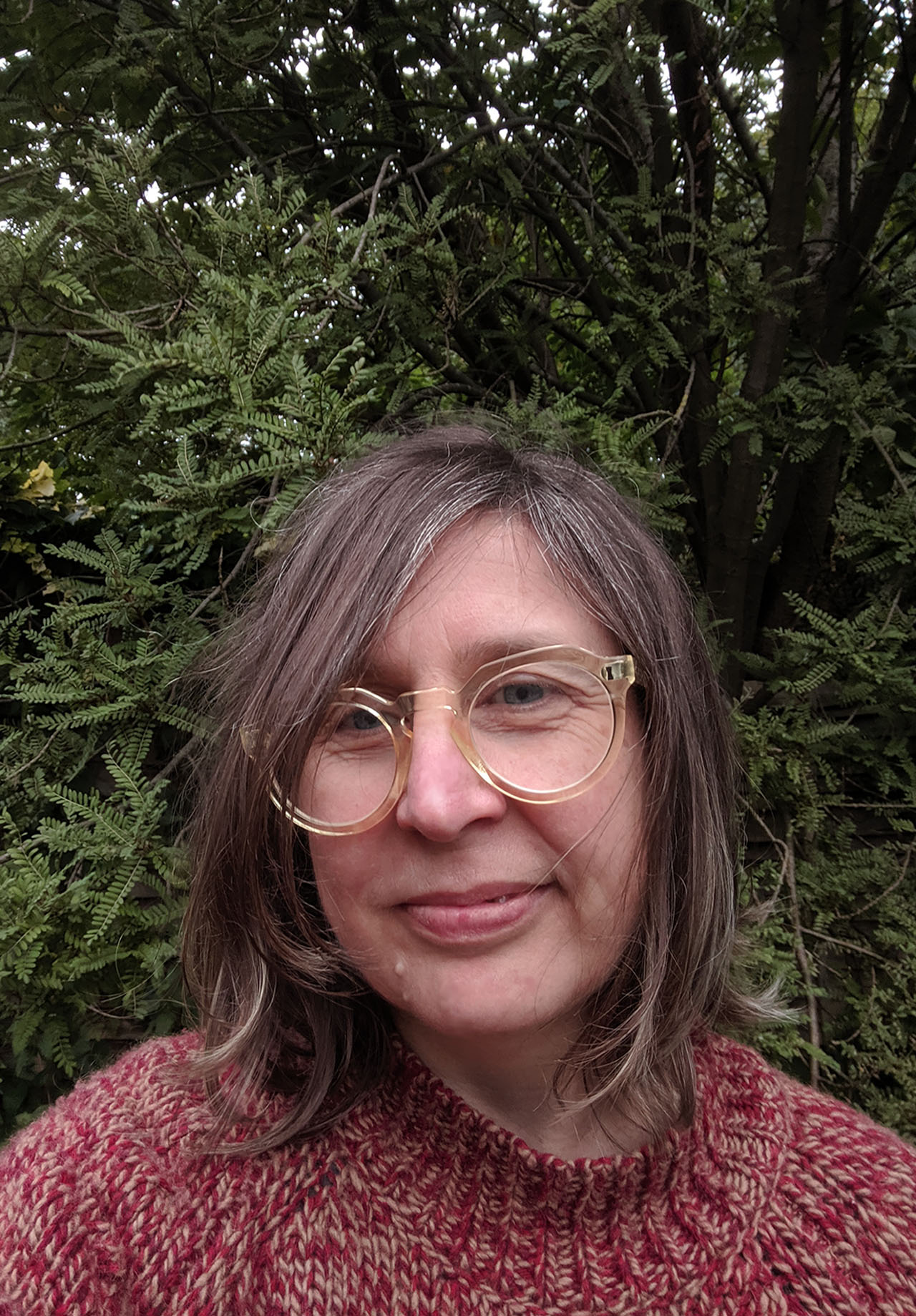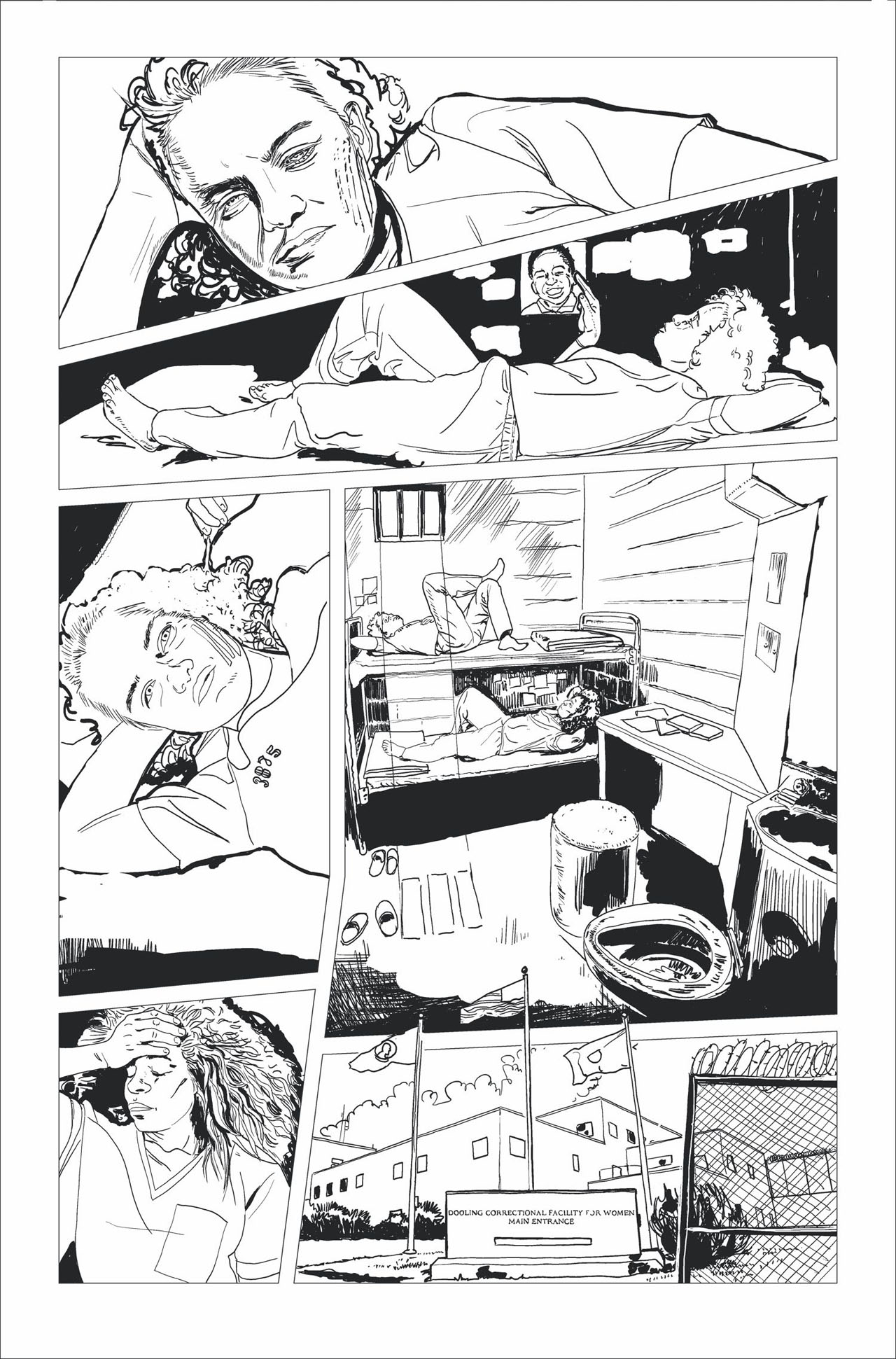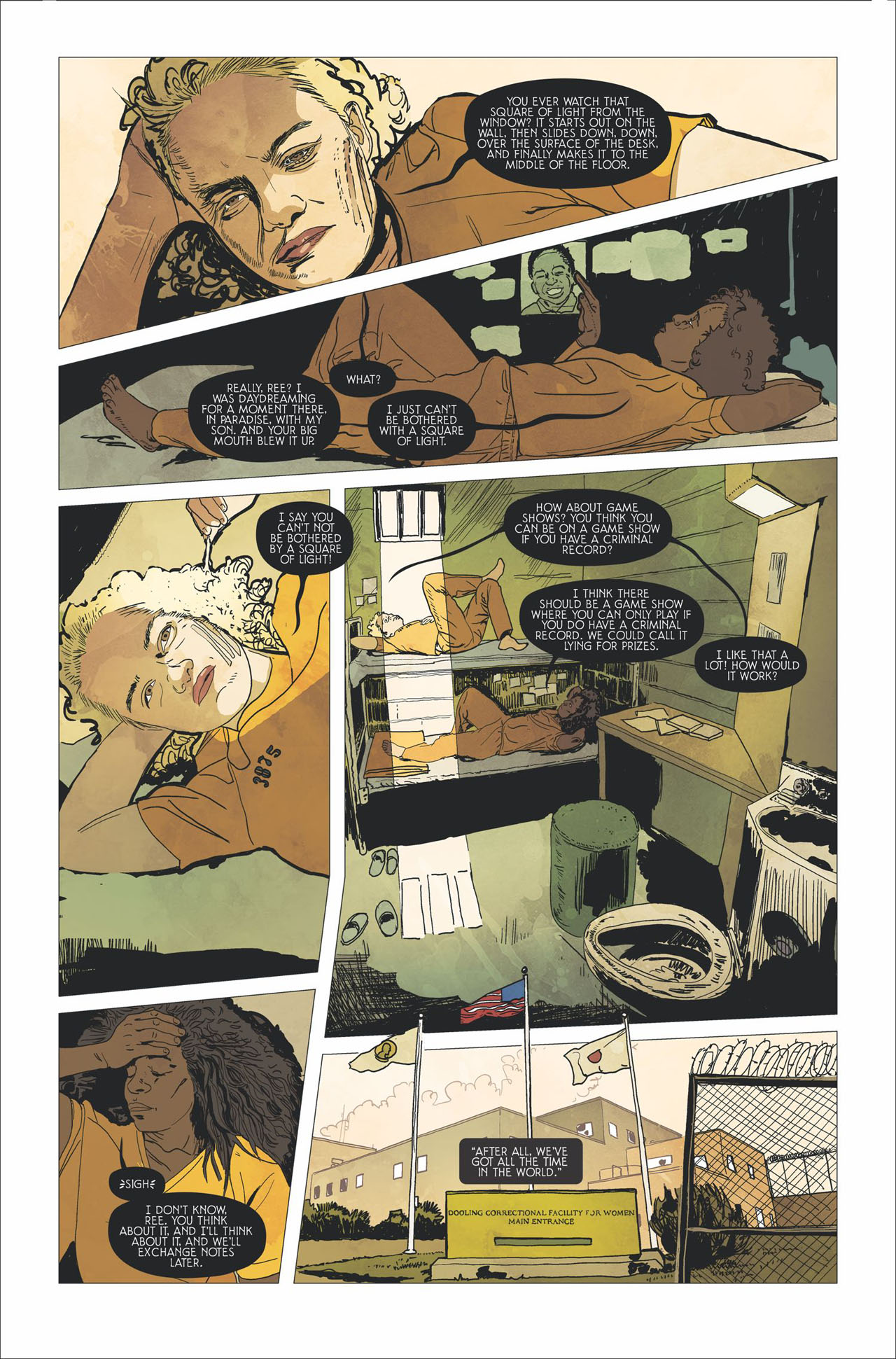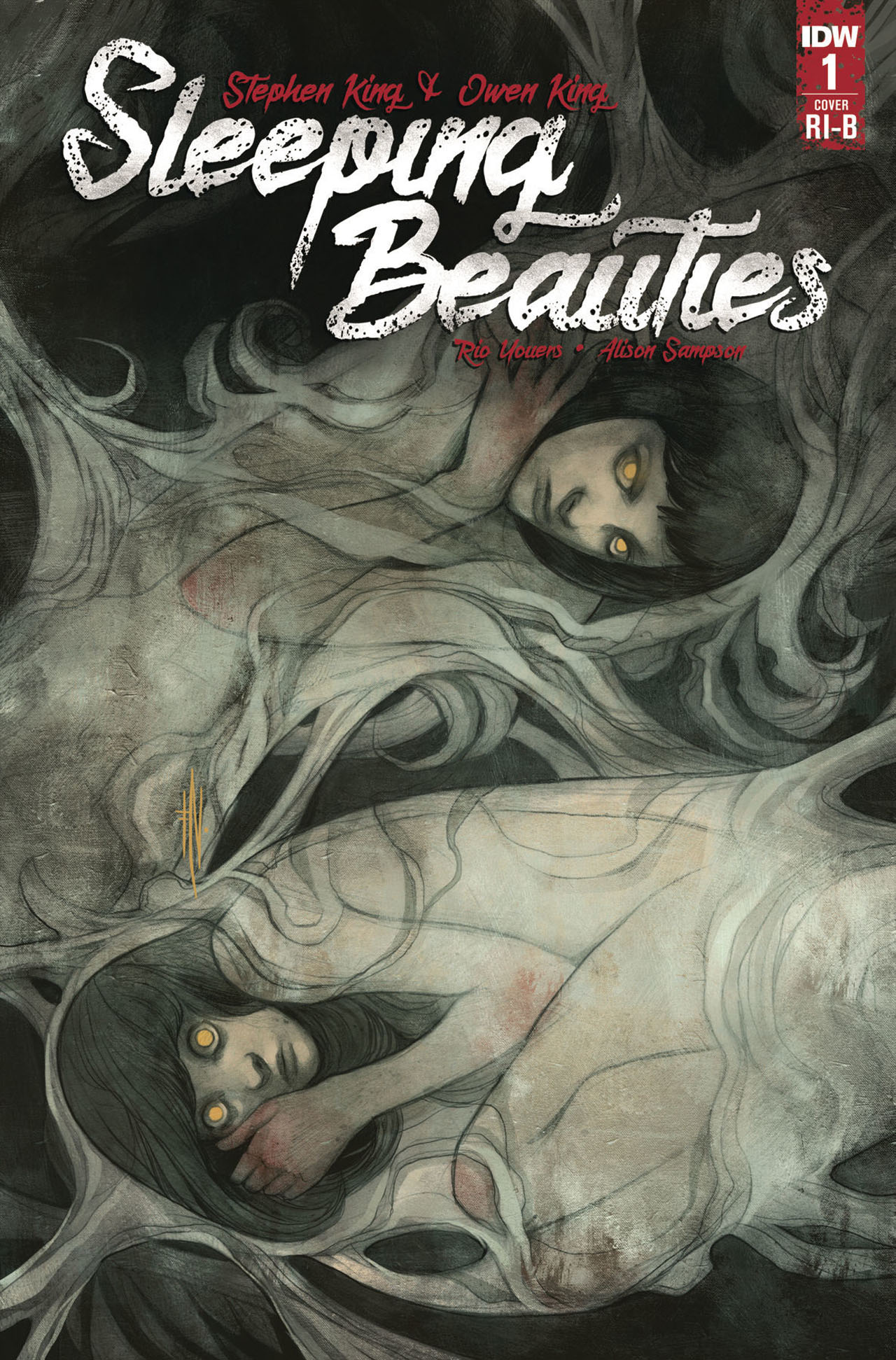Inside the adaptation of Stephen & Owen King's Sleeping Beauties to comics
You've read Grimms', seen Disney's, now experience Kings' - in comic books

In 2017, Stephen and Owen King unleashed a waking nightmare on a sleeping world. Their prose novel, Sleeping Beauties, told the story of Aurora, a global disease that put women into strange, alien comas. Now, IDW Publishing is bringing Sleeping Beauties and its curious affliction to comic readers everywhere.
To do so, IDW has put together a crack team of comic creators. Newsarama spoke with artist Alison Sampson (Winnebago Graveyard) and writer Rio Youers (The Forgotten Girl) about their experience adapting the Twilight Zone-esque horror novel; here’s what they had to say.
Newsarama: Alison, let's start with you. Sleeping Beauties has a unique, non-rectangular style of paneling. Can you talk a little bit about what inspired you to tell the story this way?

Alison Sampson: My job first and foremost is to tell the story we have, in the space that we have got (something of a task when we are condensing 700 pages of prose novel to 200 pages of graphic novel). That involves jigsawing in the panels so I can show what needs to be shown, in the way it needs to be shown, at the right size, seeing the right things, in the right reading order, with room for the dialogue, and making the whole thing look as good as possible.
So, you could say the design is pretty layered and organic.
My panels have to work hard, and I don't really have a lot of spare space. At the end of the day, I try and make the thing work and also look good. That's as much as any of us can do.
Nrama: Rio, can you speak to how you adapt a prose work into a comic? What do you include, add, and subtract?
Get the best comic news, insights, opinions, analysis and more!
Rio Youers: It's an incredibly involved process, made, in this case, even more complicated by the fact that it's a 700-page novel, and only a 200-page comic. The math doesn’t work, obviously, so something had to give. That was the hardest part, I think … making the necessary cuts, while maintaining the essence of what makes Sleeping Beauties such a vivid and startling story.

I read — and loved — the novel when it first came out. And I read it again once I was officially attached to the project and given the green light. I made copious notes, detailing what happens in every chapter. Then, with the novel’s powerful message at the forefront my mind, I broke it down into three categories: What I absolutely had to keep, what I wanted to keep if space allowed, and what I felt could be cut. Once this was done, I had a template, of sorts, which I divided into ten “issues,” ensuring I ticked all the boxes: advancing the story, developing the characters, beginning and ending each issue on a high note, and including plenty of action.
I sent the breakdown to Stephen King, Owen King, and [IDW's Chief Creative Officer] Chris Ryall, to make sure they were happy with what I’d done. They gave me the thumbs up, then it was onto the new challenge of scripting the comic. I soon found out that each scene wanted to be longer than I had room for, which required me to exercise a different part of my writing brain.
So yes, adapting Sleeping Beauties was a painstaking but ultimately fulfilling experience, which involved making numerous cuts (all of them difficult). I won’t go into extensive detail, because I want the comic to exist as its own thing — based on but separate from the novel.
As for what I added … well, I had to subtly reshape certain scenes to fit this truncated version of the story. I also endeavored to keep as much of the original dialogue as possible, but again, changes were required, so some of the dialogue is mine.

Nrama: What's your relationship with Stephen King's works before this project, Rio? Have you been a fan long?
Youers: The first Stephen King book I read was Christine, back in 1987, and that was it, boom, I was a fan, count me in! In the years since, that relationship has been consistently rewarding — not only in terms of the pleasure his stories have given me, but as an inspiration in my own work. I can say with absolute honesty that, if I hadn’t discovered Stephen King, I would not be writing today.
And hey, I want to give a shoutout to Owen King, too. I adore everything of his that I have read (which is most — if not all — of it). Double Feature is an almost unfairly great novel. Satirical, Irving-esque, with a cast of memorable characters. Owen is a true craftsman when it comes to the written word. His sentences carry such great balance and beauty. When I heard he was teaming up with his dad to write Sleeping Beauties … well, suffice to say that I knew I’d be first in line to pick up a copy. And here I am, having adapted that same novel for comics. What a surreal and unforgettable experience.

Nrama: The antagonist of the novel Sleeping Beauties is Eve Black, but I got the sense that she's the comic's main character. Alison, do you agree? And can you go into how you designed her character?
Sampson: Absolutely. I love Evie. She's the lynchpin of everything. With the amount and diversity of characters in Sleeping Beauties (the character list in the novel extends for more than three pages), I've allocated real people to the roles so I can keep clear visual distinctions. The character you see comes out of my workshopping Evie's role (and acting out the parts) with my friend Traci, who is Trinidadian. She really lights up the room, bringing Evie's amazing looks, confidence and charm to the table.
Nrama: Color really sets the mood for this book. Alison, can you describe your working process with colorist Triona Tree Farrell?
Sampson: Triona is very good at coloring my work, we've worked together before (on Hit Girl in Mumbai), and I'm confident in her ways of approaching the story, so this is really her thing. We had a chat about color at the start. I thought The Long Tomorrow (Dan O'Bannon/ Moebius) might be a good color inspiration, Triona set down some storytelling rules (color rules from 'mundane' at one extreme to 'magic' at the other), and then we went from there.
I give out color notes for each page with the time of day and mood, light sources, skin, hair and clothing colors where I need to, and any special things, and we want to keep the tone of the book upbeat, but this is nothing to what Tree does. The color magic (and it is magic) is hers.

Nrama: The lettering also sets this book apart from many others, with its white text on black bubbles, plus an inventive use of sound effects. Rio, what's it like working with Christa Meiser as letterer?
Youers: It’s always a gamble to do something different. Something as visually stunning as Sleeping Beauties … it needed that gamble to be taken, and Christa laid down aces. I love what she has done within the pages — how she compliments Alison’s art and Triona’s colors.
Watching it all come together has been a genuine pleasure, and I can’t praise the artistic team highly enough. Sleeping Beauties is such a visually appealing experience, exciting the imagination in an exotic and vivid way, and the lettering only enhances that. It’s been an absolute privilege to work alongside Christa, Alison, Triona, and our editor Elizabeth Brei. I like to think we've done something unique and special here — something that will appeal to fans of the source material, and new readers, too.
Nrama: Alison, you use the absence of black lines to create some of this book's "special effects." (Examples include the moths, cobwebs, etc.) Can you tell us how that came about?
Sampson: It probably depends which page you are referring to, but I can say this is my first digitally-drawn comic, and my first time drawing with a tablet. I'm new to the process and liking it very much. I'm still trying to keep constraints (largely the same brush) but I'm finding there's so much more that can be done- why should we not draw in white on black, if we can? As with the paneling, I go where telling the story leads, and if that is not down a conventional route, then it isn't. I try and follow how we perceive things. "Correct" perspective and detailed definition of everything *do not always* tell us what a thing is- they assume modes of seeing that just do not exist, and that we do not always need. Also, I'm feeding into what Triona is doing. There is a little bit of relinquishing control there, something I'm just learning to do.

Nrama: Since you started working on this book, a real pandemic has stretched across the globe. Rio, does this change your view of this story?
Youers: Not really. I mean, it has certainly added a darker edge — we all know what it’s like to live through a global pandemic now — but COVID-19 and Aurora are different enough that it’s never an uncomfortable experience.
One of the things that has really struck me during COVID is that we have frequently seen the good in people, from our friends and neighbors to the fantastic and tireless efforts of our frontline workers. This is not always the case in Sleeping Beauties. Believe me, there are a lot of bad guys within these pages.
Emphasis on guys.
Nrama: The last question is for the both of you. In your opinion, what's the future of horror in comics?

Youers: The same as with every other medium, I think. There will always be a robust audience for it. I love that comics offer the visual gratification of a movie, with the page-turning vibe of a great novel. A comic is neither one, nor the other, but — in many ways — a perfect blend of the two. And there have been some fantastic horror comics in recent years: Harrow County; Gideon Falls; Locke & Key; House of Whispers. Creators and publishers are putting out top-level material, and you can bet this will continue for many years to come.
Sampson: How long have you got? Horror can be a very broad definition, but largely you are making something I would describe as an emotional testbed, where we ask some fairly fundamental questions about how we live and what it is to be human. We set up 'what if' scenarios that then ask sometimes uncomfortable questions of the reader. All those hidden things are brought to light. I'm interested in making horror stories with content and for readers that go beyond the superficial gore, in this way, stories which the reader can get inside of. Science fiction and fantasy has had an explosion of diverse voices making some really exciting stories in the past few years. Horror has barely got started with this, but I'm very excited as to where it will go.

Grant DeArmitt is a NYC-based writer and editor who regularly contributes bylines to Newsarama. Grant is a horror aficionado, writing about the genre for Nightmare on Film Street, and has written features, reviews, and interviews for the likes of PanelxPanel and Monkeys Fighting Robots. Grant says he probably isn't a werewolf… but you can never be too careful.


